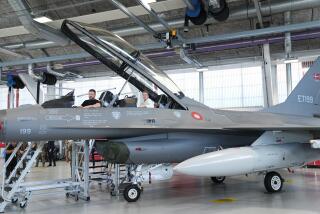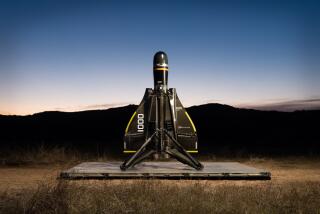F-16 Project Focuses on Direction : Defense: Pilots at Edwards Air Force Base test technology that experts hope will ‘develop the most agile aircraft in the world.’
EDWARDS AIR FORCE BASE — In modern dogfights, according to those who have survived them, it’s the pilot who is first able to point his plane at his opponent’s who usually wins.
At Edwards Air Force Base, an F-16 is being tested with modifications intended to give U. S. fighter pilots the edge in the deadly race to point first.
Known as Multi-Axis Thrust Vectoring (MATV), the $34-million program relies on a technologically advanced exhaust nozzle that allows the pilot to point the F-16 in one direction while continuing to fly in another.
Rather than relying solely on aerodynamics, using the aileron and rudder, to control the movements of an aircraft traveling at lower speeds, MATV also uses the thrust of the jet exhaust to change the altitude of the plane relative to its direction of travel. A nozzle, developed by GE Aircraft Engines, directs engine thrust both up and down as well as side to side, forcing the tail in the opposite direction to swing the aircraft’s nose.
“The goal of the program . . . is to develop the most agile aircraft in the world,” according to an Air Force statement.
MATV is being tested on an F-16 known as VISTA, for Variable Stability In-Flight Simulation Test Aircraft. The VISTA was developed for testing MATV in the control of fighter aircraft. The program is being carried out by the Wright Laboratory at Wright-Patterson Air Force Base in Ohio.
Since it arrived at Edwards on July 15, the test plane has been flown 120 hours during 86 flights.
Most of the test flights are done at low airspeeds, below about 445 m.p.h., and high angles of attack--the angle between the direction a plane is flying and where its nose is pointing.
A standard F-16 is capable of an angle of attack of only about 25 degrees. In flight tests at Edwards, the MATV-equipped plane has exceeded 180 degrees--swinging all the way around and briefly flying backward--with a maximum stabilized angle of 83 degrees.
A pilot visiting from another Air Force Base who flew the modified F-16 said, “This jet is much more lethal than a normal F-16 would be.”
To the Air Force test pilot, Maj. Mike Gerzanics, multi-axis thrust vectoring will be standard technology for 21st-Century fighter aircraft.
Previous thrust vectoring technologies--such as those used successfully by British Sea Harriers against the Argentines in the Falklands War--have been limited to up and down movement.
The F-22 Advanced Tactical Fighter, considered the next generation fighter jet, will be equipped with thrust vectoring. But it is not as advanced as the MATV system.
The multi-axis thrust vectoring system is fully integrated into the aircraft. The pilot simply uses the stick and foot pedals to control the aircraft movement and a computer electronically determines the necessary movements of the rudder, ailerons and the vectoring exhaust nozzle.
“We have the technology to fly where the opponent can’t,” said Gerzanics.
Les Small, MATV program manager, said another important factor of the system is that it reduces the opportunities for loss of control of an aircraft.
There is only about one month left in the MATV flight test program. The exhaust nozzle will be removed from the aircraft and Wright Laboratory will continue with its VISTA program.
The contractor team on MATV--Lockheed Fort Worth Co. and GE Aircraft Engines--which has covered about 80% of the program cost, hopes the government will decide to modify its fighter aircraft fleet with the exhaust nozzles.
Small said it has not yet been determined how much it would cost to equip existing F-16s and other planes with the GE exhaust nozzle, but that it would probably cost several million dollars per aircraft.
More to Read
Sign up for Essential California
The most important California stories and recommendations in your inbox every morning.
You may occasionally receive promotional content from the Los Angeles Times.










